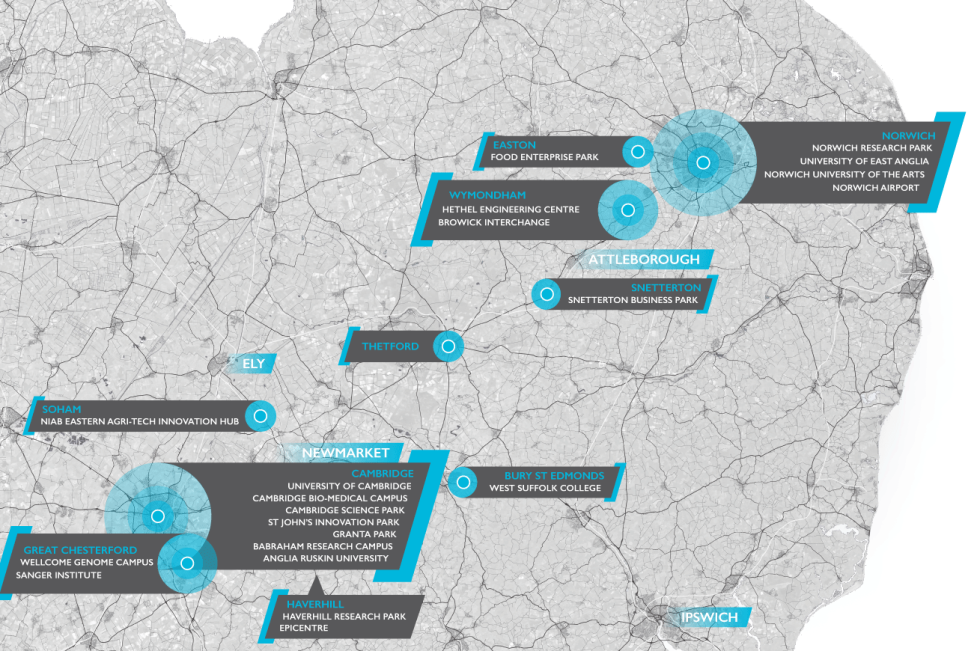63
Greater Norwich is key to the region’s economy with considerable potential for growth in world class knowledge intensive jobs. As a major part of the country’s largest agri-food sector, and as a world leader in plant, microbial and climate change research, the growing economy of Greater Norwich is well-placed to make a major contribution to living with environmental change and ensuring food security. Advanced intelligent information technology businesses in Greater Norwich, along with the wider area’s position as the world’s leading provider of offshore wind energy, mean that the area can also play a key role in promoting energy security through sustainable sources. Taken together, this means that Greater Norwich is well equipped to make a significant contribution to the major environmental and economic challenges of the 21st century, developing a post-carbon economy locally which will contribute greatly to sustainable economic change nationally and internationally.
64
Strategic employment sites and competitive land and business lets24, mainly those in and around the Norwich and Wymondham area, support the globally significant growth axis within the Cambridge Norwich Tech Corridor25 (as shown in map 126 below)
65
The vibrant, attractive city centre of Norwich is a nationally significant retail centre and a catalyst for economic growth across Greater Norwich, encouraging investment into the area. Market towns at Diss, Harleston and Aylsham and other local employment sites provide accessible employment for rural areas.
66
Between 2011-18 modelling27 shows a 14.6% rise in total employment (29,100 jobs). This included notable increases in jobs in the accommodation and food sectors, IT and communications, professional, scientific and technical professions, education and health, contributing to the 50% regional growth in Science and Research and Development employment since 2007 compared with 19% UK average28. However, employment in agriculture, manufacturing and insurance fell.
67
Greater Norwich also strongly features most of the sectors identified as having high growth potential regionally29. These include: advanced manufacturing and engineering at Hethel; agri-tech, health and life sciences at the Norwich Research Park (NRP) and the Food Enterprise Park; and IT and communications and digital creative industries in the city centre. Greater Norwich’s other strengths include financial services, tourism, retail, media and the arts. The area also benefits from a strong and growing tertiary education sector provided by UEA, NUA, City College Norwich and Easton College which contribute research expertise and a skilled workforce.
Highlights of the Greater Norwich economy30
- The life-science sector has a skilled workforce of 15,000 in the Norwich cluster and the Norwich Research Park is the UK’s largest site for research in food, health and life sciences;
- Agri-tech is a sector worth £3.6 billion and Easton College provides 5,000 students with training in the area which feed into the sector;
- IT and communications and digital creative industries account for a sector worth £1.4 billion with over 100 companies in Norwich and a workforce of 7,500, including large numbers of graduates from the local universities;
- The financial sector employs more than 11,500 people and contributes £1 billion to the local economy;
- Greater Norwich boasts an extensive and varied leisure and culture offer. The tourism sector is worth £3 billion and the visitor economy supports 54,000 skilled workers thanks to the growing number of day visitors, currently estimated at 40 million per year, and 12 million overnight visitors. Visitor attractions include a wide variety of historic buildings, parks and museums, cultural festivals and other regular events, along with access to the Broads and the coast. Sports and leisure facilities include numerous attractive open spaces and routes for walking and cycling, a dry ski slope, the only Olympic sized swimming pool in the region, leisure centres, Norwich City Football Club, theatres, cinemas, music venues and restaurants and bars;
- Retail remains the largest provider of employment in the area. Norwich is rated as the 13th best performing retail centre nationally and our market towns also have a strong local retail offer.
68
In December 2013, the Greater Norwich City Deal was signed, which is building on the area’s leading status in science, technology and advanced manufacturing and focusses on enterprise, skills and infrastructure.
69
Employment rates in Greater Norwich compares favourably to national trends, with rates of claimants for Jobs Seekers Allowance and Universal Credit below regional and national levels.31
70
Rural enterprises are important to the local economy and home working is increasing in significance. The proportion of micro-businesses employing up to nine people is above the national average in Broadland and South Norfolk. Signs are that new and small businesses can flourish and the survival rate of newly established enterprises is good32
71
The GNLP should support the growth of a wide ranging and changing economy, ranging from high tech businesses with the capacity for major growth through to smaller rural enterprises.
Overleaf – Map 1 The Cambridge Norwich Tech Corridor

Footnotes
24Source as above – On average, business lets are 45% cheaper in Greater Norwich than in London or Cambridge
25See https://www.techcorridor.co.uk/
26Source: Invest in Greater Norwich
27Source: Cambridge Econometrics: ‘East of England Forecasting Model: 2016 baseline results’
28Source: Norfolk and Suffolk Unlimited – Draft Local Industrial Strategy (2020)
29Sectors identified in the New Anglia Local Enterprise Partnership’s Economic Strategy for Norfolk and Suffolk.
30Source: Invest in Greater Norwich
31Source: https://www.norfolkinsight.org.uk/economy-and-employment/